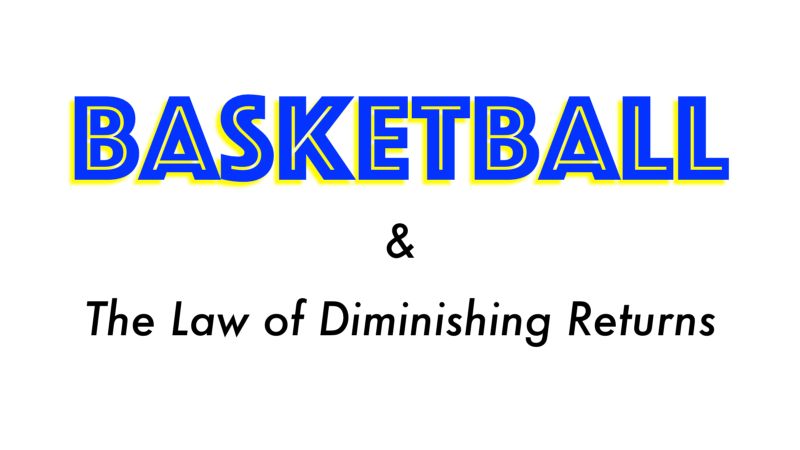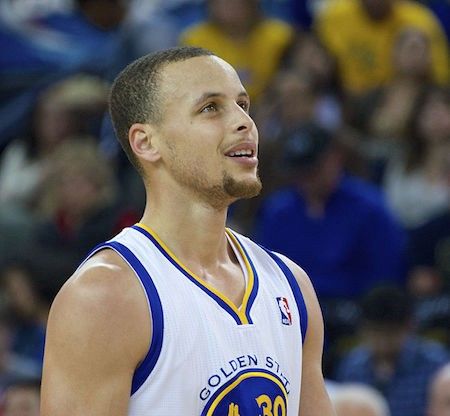Basketball and the Law of Diminishing Returns

Let’s start with a very simple thought experiment. Visualize something you consider to be good. Now add to it whatever you think would make it even better.
Did this come easy to you? I suspect most of us will be able to do this rather effortlessly. What this shows is we intuitively operative with an additive theory of good.
To put this in terms of simple mathematics: two is greater than one. To use a harder mathematical concept: goodness is combinatorial.
Let’s ditch the math and focus on a (delicious) example instead. A bowl of Blue Bell Homemade Vanilla ice cream is a beautiful thing, isn’t it? Now add to it a handful of chocolate chips, drizzle some rich fudge over it, and you’ve now got a concoction that would even make Remy from Ratatouille blush.
Not so fast. Enter: the Law of Diminishing Returns.
Here’s how the Encyclopedia Brittanica defines this law:
If one input in the production of a commodity is increased while all other inputs are held fixed, a point will eventually be reached at which additions of the input yield progressively smaller, or diminishing, increases in output.
Though it seems intuitive to believe that a bunch of good things, when combined, always result in something even better, in theory, the Law of Diminishing Returns demonstrates the flaw in this thinking. Economics teaches us that an assembly line can be an effective way to maximize output while minimizing investment. However, stick too many workers on the line and your productivity will suffer.
My thesis is that the Golden State Warriors may be on the brink of experiencing the woes of diminishing returns.
Despite what public opinion suggests, it is possible the Warriors have added too many skilled parts to an already high-functioning machine. If it does turn out that Kevin Durant becomes a destabilizing force, as opposed to an enhancement, it will simply be the latest piece of confirmation of the accuracy of the law of diminishing returns.

This has nothing to do with Durant himself. The point isn’t that there are certain deficiencies to his game that will cause the Warriors to struggle. When healthy, Kevin Durant is one of the top three players in the league, surpassed only by LeBron James and Durant’s newest teammate, Steph Curry. Every team in the league would kill to land him.
The point, rather, is that with the addition of Durant, the Warriors may be too good for their own good.
So with less than a month before the NBA season kicks off — THANK YOU, LORD! — let’s allow a little Warriors cynicism into our lives. Let’s let a contrarian contemplation of their roster assist us in setting realistic expectations for this squad from Oakland.
Have you heard some variation of the following Hot Take? ”Forget it. Why bother even having this season? Just give them the trophy already.”
Perhaps you too may have fallen victim to this viewpoint. Perhaps as a fan of a different team, haunted by the specter of a potential playoff matchup against a squad of unstoppable supersnipers, you too have come to see them as basically invincible.
As a natural contrarian, I’m inclined to counter these thoughts with the trademarked words of ESPN’s Lee Corso: “Not so fast, my friend.”

I suspect that KD may be one superstar too many for the Warriors, and here are two quick reasons why.
(1) A Hurting Bench
In order to land Durant, the Warriors had to let some players go. Not only were some of these players integral to their past success, but chemistry wise, many of them seamlessly meshed with Head Coach Steve Kerr’s carefully planned lineups and schemes.
This season, the Warriors will be without Harrison Barnes, Andrew Bogut, Festus Ezeli, Leandro Barbosa, and Marreese Speights. None of these players hold a candle to Kevin Durant on an individual level — but basketball often requires good fit and not just aggregation of talent.
(2) There is only one ball
By adding Durant, a player who demands lots of touches and shots, to the Warriors’ starting five, this reduces the share of offensive participation that Steph Curry and Klay Thompson can expect to have this season. It would be easy to assume this is a benefit rather than a drawback, but keep in mind that adjustments on this level are not necessarily easy to make. Steph and Klay have been used to a certain level of offensive participation that may be reduced now that Durant is factored into the mix. There’s a reason why James Harden functioned better as a sixth man than as a starter while on the Oklahoma City Thunder.
Less importantly for team success, though still interesting from a fan’s point of view, the introduction of KD could mean we won’t get to see Curry surpass his NBA-record 402 made three-pointers in a single season. The overall point is that it’s unclear whether the Warriors can accommodate this much offensive firepower. To give a concrete example, Steph and Draymond’s average touches per game according to NBA.com’s Player Tracking, 86 and 81, respectively, will need to be lowered in order to make room for KD’s 65 touches per game.

Am I suggesting the Warriors shouldn’t be considered favorites to win it all? Of course I’m not saying that. They definitely should be seen as the favorites.
I’m just trying to pump the brakes on the Crown Them movement. I think a case can be made for thinking that the Warriors have introduced too much goodness. To be sure, all metrics, reason, and logic point to this squad as being the next NBA champions. But that’s what we all thought last year, too.
So while fans and experts are quickly conceding the Larry O’Brien over to the kids out West, I simply sit back and offer the same challenge David Patrick Kelly does as “Luther” in a 1979 cult classic: “Warriors, come out to plaaaaayyaaayyyy!”
Source: thearcmag.com


